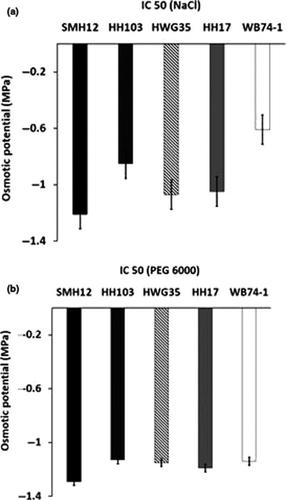当前位置:
X-MOL 学术
›
Food Energy Secur.
›
论文详情
Our official English website, www.x-mol.net, welcomes your
feedback! (Note: you will need to create a separate account there.)
Improvement of rhizobium‐soybean symbiosis and nitrogen fixation under drought
Food and Energy Security ( IF 4.0 ) Pub Date : 2019-05-30 , DOI: 10.1002/fes3.177 Tsholofelo Kibido 1, 2 , Karl Kunert 1, 2 , Matome Makgopa 1 , Michelle Greve 1 , Juan Vorster 1, 2
Food and Energy Security ( IF 4.0 ) Pub Date : 2019-05-30 , DOI: 10.1002/fes3.177 Tsholofelo Kibido 1, 2 , Karl Kunert 1, 2 , Matome Makgopa 1 , Michelle Greve 1 , Juan Vorster 1, 2
Affiliation

|
The symbiotic interaction between soybean plants and rhizobacteria can be severely affected by drought, which results in a reduction in symbiotic nitrogen fixation and ultimately decreased yields. The aim of our research was to determine whether symbiotically efficient rhizobia that can better tolerate soil water deficits can improve nodule performance in plants subjected to drought. Firstly, rhizobial strains were selected that exhibited differences in tolerance to salt (NaCl) or water deficit (PEG 6000). Sinorhizobium fredii strain SMH12 showed the highest tolerance to these treatments while Bradyrhizobium diazoefficiens strain WB74‐1 showed the lowest tolerance. Greenhouse‐grown Prima 2000 soybean plants were then inoculated with either SMH12 or WB74‐1 and subjected to two water deficit regimes. Different nodule and plant growth traits were determined, including nodule number, dry weight, water potential, and the accumulation of malondialdehyde and ureide. Plants inoculated with SMH12 had significantly more nodules under water deficit conditions than those inoculated WB74‐1, despite having lower root and shoot biomass. SMH12‐inoculated plants had higher nodule water potentials and lower malondialdehyde contents than the WB74‐1‐inoculated plants. These results demonstrate that inoculation of soybean plants with the more water deficit‐tolerant S. fredii strain improved nodule characteristics when plants were grown under water deficit conditions. However, these improved nodule characteristics do not always directly translate into better plant growth.
中文翻译:

干旱条件下改善根瘤菌-大豆共生和固氮作用
大豆植物和根际细菌之间的共生相互作用会受到干旱的严重影响,这导致共生固氮减少,最终产量降低。我们研究的目的是确定能够更好地耐受土壤水分亏缺的共生高效根瘤菌能否改善干旱植物的根瘤性能。首先,选择表现出对盐(NaCl)或水分缺乏(PEG 6000)耐受性差异的根瘤菌菌株。费氏中华根瘤菌SMH12菌株对这些治疗的耐受性最高,而重氮根瘤菌WB74-1菌株显示出最低的耐受性。然后将温室种植的Prima 2000大豆植株接种SMH12或WB74-1,并进行两种缺水处理。确定了不同的根瘤和植物生长特性,包括根瘤数量,干重,水势以及丙二醛和脲的积累。尽管根和茎生物量较低,但在缺水条件下,接种SMH12的植物的根瘤明显多于WB74-1。与WB74-1接种的植物相比,接种SMH12的植物具有更高的根瘤水势和更低的丙二醛含量。这些结果表明,对大豆的接种具有更高的耐缺水链球菌。当植物在缺水条件下生长时,该菌株改善了根瘤特性。然而,这些改善的根瘤特性并不总是直接转化为更好的植物生长。
更新日期:2019-05-30
中文翻译:

干旱条件下改善根瘤菌-大豆共生和固氮作用
大豆植物和根际细菌之间的共生相互作用会受到干旱的严重影响,这导致共生固氮减少,最终产量降低。我们研究的目的是确定能够更好地耐受土壤水分亏缺的共生高效根瘤菌能否改善干旱植物的根瘤性能。首先,选择表现出对盐(NaCl)或水分缺乏(PEG 6000)耐受性差异的根瘤菌菌株。费氏中华根瘤菌SMH12菌株对这些治疗的耐受性最高,而重氮根瘤菌WB74-1菌株显示出最低的耐受性。然后将温室种植的Prima 2000大豆植株接种SMH12或WB74-1,并进行两种缺水处理。确定了不同的根瘤和植物生长特性,包括根瘤数量,干重,水势以及丙二醛和脲的积累。尽管根和茎生物量较低,但在缺水条件下,接种SMH12的植物的根瘤明显多于WB74-1。与WB74-1接种的植物相比,接种SMH12的植物具有更高的根瘤水势和更低的丙二醛含量。这些结果表明,对大豆的接种具有更高的耐缺水链球菌。当植物在缺水条件下生长时,该菌株改善了根瘤特性。然而,这些改善的根瘤特性并不总是直接转化为更好的植物生长。










































 京公网安备 11010802027423号
京公网安备 11010802027423号